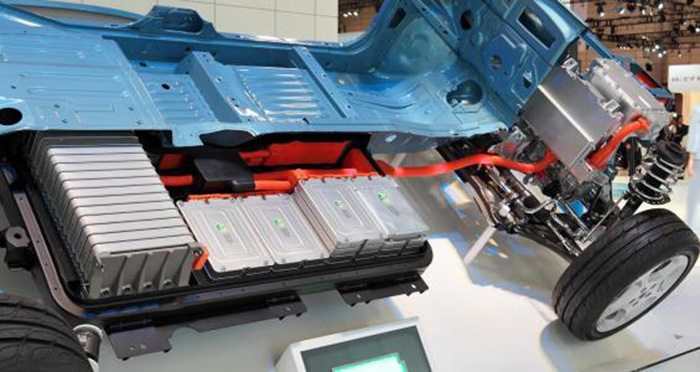The EV battery pack housing is the load-bearing part of the electric vehicle power battery, which is generally installed in the lower part of the car body, and is mainly used to protect the lithium battery from being damaged by external collisions and squeezing.
The traditional car battery pack housing is cast from steel plate, aluminum alloy and other materials, and then the surface is sprayed.

With the development of energy saving, environmental protection and lightweight of the car, a variety of lightweight material options such as glass fiber reinforced composite materials, SMC sheet materials, and carbon fiber reinforced composite materials have also appeared in battery pack housing materials.
The steel battery pack housing is the most primitive power battery pack case material. It is generally welded by cast steel plates. It is characterized by high strength, high rigidity and heavy weight.
The surface of the battery pack case needs to be treated with anti-corrosion, so that it has a good anti-corrosion effect under long-term high temperature conditions.
The EV power battery pack shell adopts aluminum alloy material, which has the characteristics of easy processing and forming, high temperature corrosion resistance, good heat transfer and electrical conductivity.
The EV battery pack aluminum alloy shell (except for the shell cover) can be stretched and formed at one time. Compared with stainless steel, the welding process of the bottom of the box can be omitted, and there will be no problems such as the deterioration of the cold wind quality due to the burning of metal elements during welding.
In addition, the aluminum alloy shell EV battery pack has the following four advantages.
1.long lasting. The simulated aging test of aluminum alloy shell shows that its service life is more than 20 years, which far exceeds that of traditional materials such as metal.
2. Flame retardant, smokeless and non-toxic. The flame retardancy of aluminum alloy materials can reach FV0, and the amount of smoke generated under high temperature burning can reach level 15, the smoke is non-toxic, and the toxicity level is ZA1 (quasi-safety level).
3. Explosion-proof performance. The aluminum shell cover of the EV power battery is specially equipped with an explosion-proof device. When the internal pressure of the battery is too high, the explosion-proof device will automatically open and release the pressure to prevent explosion.
4. Anti-aging performance. Among metal materials, aluminum has excellent anti-aging properties. The anti-aging performance test shows that the maximum aging thickness of the surface is less than 50μm in 20 years in different places of use and different climatic zones. The minimum thickness of most boxes is 5mm, which is less than 1% of the thickness of the box, so it has no obvious impact on the mechanical properties of the box.
SMC composite material, that is, sheet molding compound, the main raw materials are composed of GF (special yarn), UP (unsaturated resin), low shrinkage additives, MD (filler) and various additives.
SMC composite materials have the following 7 characteristics.
1. Good electrical performance. SMC composite material not only has excellent electrical insulation, but also maintains good dielectric properties at high frequencies, free from electromagnetic effects, and does not reflect electromagnetic waves.
2. Resistant to chemical corrosion. SMC composite materials have good corrosion resistance characteristics such as acid, dilute alkali, salt, organic solvents, and seawater, while metal materials are not resistant to acids and seawater.
3. Lightweight and high strength. The specific modulus of SMC composite material is equivalent to that of steel, but its specific strength can reach 4 times that of steel.
4. Notch sensitivity. When the construction is overloaded and a small amount of fiber breaks, the load is quickly distributed on the broken fiber to reach mechanical equilibrium again. This is incomparable to metal components.
5. Low thermal conductivity and small expansion coefficient. When there is a temperature difference, the thermal stress generated is much smaller than that of metal.
6. Excellent UV resistance and aging resistance. The maximum aging thickness of the surface is less than 50μm in 20 years. The minimum thickness of most boxes is 5mm, which is less than 1% of the thickness of the box, so it has no obvious impact on the mechanical properties of the box.
7. Good fatigue resistance. The tensile strength of SMC composites is slightly better than that of steel. The fatigue resistance of steel and most metal materials is generally higher than this value, up to 70%-80%.
Carbon fiber reinforced composite material is one of the effective ways to solve the development of lightweight automobile. At present, carbon fiber composite material has become an ideal substitute for traditional metal battery box.
The density of carbon fiber is about 1.7g/cm3. Tensile strength 3000MPa, elastic modulus 230GPa, light weight, high strength, high temperature resistance, friction resistance, shock resistance, and low thermal expansion coefficient.
The density of steel is 7.85g/cm3, tensile strength is 300-600MPa, elastic modulus is 190GPa, specific heat capacity is 0.42J/(KG.K), thermal expansion coefficient is 10.6-1.22×10-6/℃, and its density is higher than carbon fiber Many, the tensile strength is not as good as carbon fiber.
The density of aluminum is 2.7g/cm3, the tensile strength is 110~136MPa, and although the weight is lighter than steel, the strength is also lower and the safety performance is slightly worse.
In addition, carbon fiber composite materials have absolute advantages in impact resistance, airtightness, and weight reduction.
Founded in 2011, WinAck Battery has always focused on the R&D, production and sales of battery pack assembly line and battery testing equipment.
Contact: WinAck
Phone: 0086- 188 0506 7911
Tel: 0086- 592 - 7297239
Email: timi@winack.com
Add: WinAck Group, Xiangbei Industrial Zone, Xiamen City, China